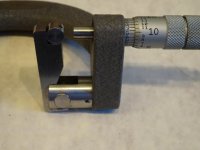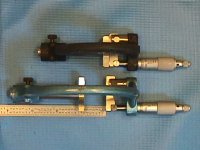GrievousAngel
Plastic
- Joined
- Jun 2, 2021
I have several reamers suited for small holes (~3/16") as used on typical bridge pins in acoustic guitars. In using one that I thought was 5 deg taper, but it over sized my bridge pin hole! I've measured taper angle(s) using a cheap digital angle measurement device with opposite reamer side on a granite (Grade B) layout block, but they all fell around angle I thought they were. I understand machining tolerances effects on real-world parts, i.e, could be disappointing at best.
The formula I kinda remember is: tan (alpha) = (D.large - D.small) / 2L or something like that. Of course I could Google it to be certain.
My question is: If you had a tapered reamer in-hand, how would you determine taper in degrees (labeled or not)?
BTW: Typical tapers for acoustic guitar bridge pins are either 3 or 5 degrees. Bridge pins should only be tight enough so if you slightly pushed pin into pin hole and then turned guitar over, the pin should not fall out. The pin is the critical acoustic interfacing element for transferring string vibration into guitar body. Many debate if pin should slotted (grooved) for string placement or left unslotted. Slotted seems to be more popular. Anyways ...
Thanks
The formula I kinda remember is: tan (alpha) = (D.large - D.small) / 2L or something like that. Of course I could Google it to be certain.
My question is: If you had a tapered reamer in-hand, how would you determine taper in degrees (labeled or not)?
BTW: Typical tapers for acoustic guitar bridge pins are either 3 or 5 degrees. Bridge pins should only be tight enough so if you slightly pushed pin into pin hole and then turned guitar over, the pin should not fall out. The pin is the critical acoustic interfacing element for transferring string vibration into guitar body. Many debate if pin should slotted (grooved) for string placement or left unslotted. Slotted seems to be more popular. Anyways ...
Thanks




